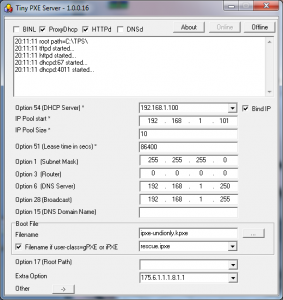About SystemRescueCD :
Description: SystemRescueCd is a Linux system rescue disk available as a bootable CD-ROM or USB stick for administrating or repairing your system and data after a crash. It aims to provide an easy way to carry out admin tasks on your computer, such as creating and editing the hard disk partitions. It comes with a lot of linux software such as system tools (parted, partimage, fstools, …) and basic tools (editors, midnight commander, network tools). It can be used for both Linux and windows computers, and on desktops as well as servers. This rescue system requires no installation as it can be booted from a CD/DVD drive or USB stick, but it can be installed on the hard disk if you wish. The kernel supports all important file systems (ext2/ext3/ext4, reiserfs, btrfs, xfs, jfs, vfat, ntfs), as well as network filesystems (samba and nfs).
Now as you have understood by now, whenever I can, I skip burning CD/DVD’s and will at worse use a USB stick or at best use PXE Boot.
Lets use TinyPXE Server + iPXE.
First lets prepare our iPXE script (save it to rescue.ipxe)
#!ipxe
set boot-url http://${next-server}
kernel ${boot-url}/sysrcd-4.1.0/isolinux/rescue32 dodhcp netboot=${boot-url}/sysrcd-4.1.0/sysrcd.dat
initrd ${boot-url}/sysrcd-4.1.0/isolinux/initram.igz
boot
Then lets prepare our files
Extrat the content of SystemRescueCD iso to /sysrcd-4.1.0, next to TinyPXE Server.
You can use 7Zip for this operation.
Now, lets setup TinyPXE Server
Now, lets boot !

help. I Have tried serveral options but i will not work
Where I extract the files from the iso?
In your video, I see: http://192.168.1.100/_iso/sysrcd-4.1.0/
Prepare our files :Extrat the content of SystemRescueCD iso to /sysrcd-4.1.0, next to TinyPXE Server.
12:24:45 PM ROOT=E:\_TinyPxeServer-SystemRescueCd\pxesrv\files\
12:24:45 PM DHCPd:67 started…
12:24:45 PM TFPTd started…
12:24:45 PM HTTPd started…
12:25:10 PM DHCPd:DISCOVER received, MAC:00-0C-29-AB-EF-33, XID:2AABEF33
12:25:10 PM DHCPd:OFFER sent, IP:192.168.2.35, XID:2AABEF33
12:25:12 PM DHCPd:REQUEST received, MAC:00-0C-29-AB-EF-33, XID:2AABEF33
12:25:12 PM DHCPd:ACK sent, IP:192.168.2.35, XID:2AABEF33
12:25:12 PM TFTPd:DoReadFile:ipxe-undionly.kpxe B:1456 T:0
12:25:12 PM TFTPd:TransferComplete=True (192.168.2.35:2070)
12:25:14 PM DHCPd:DISCOVER received, MAC:00-0C-29-AB-EF-33, XID:441D6D58
12:25:14 PM DHCPd:iPXE user-class detected
12:25:14 PM DHCPd:OFFER sent, IP:192.168.2.36, XID:441D6D58
12:25:15 PM DHCPd:DISCOVER received, MAC:00-0C-29-AB-EF-33, XID:441D6D58
12:25:15 PM DHCPd:iPXE user-class detected
12:25:15 PM DHCPd:OFFER sent, IP:192.168.2.36, XID:441D6D58
12:25:17 PM DHCPd:REQUEST received, MAC:00-0C-29-AB-EF-33, XID:441D6D58
12:25:17 PM DHCPd:iPXE user-class detected
12:25:17 PM DHCPd:ACK sent, IP:192.168.2.36, XID:441D6D58
12:25:18 PM HTTPd:Connect: 192.168.2.36, TID=6296
12:25:18 PM HTTPd:Client: 192.168.2.36 [GET] /rescue.ipxe
12:25:18 PM HTTPd:DisConnect: TID=6296
#!ipxe
set boot-url http://${next-server}
kernel ${boot-url}/RescueCD/isolinux/rescue32 dodhcp netboot=${boot-url}/RescueCD/sysrcd.dat
initrd ${boot-url}/RescueCD/isolinux/initram.igz
boot
in Tiny:
pxe-undionly.kpxe
rescue.ipxe
http://192.168.2.22/rescue.ipxe…. No such file or directory
no more network devices
Operating System not found
Stop
Sorry, forget my question
I found the solution stupid stupid
My rescue.ipxe was named: rescue.ipxe.ipxe .ipxe in the name
Now its working